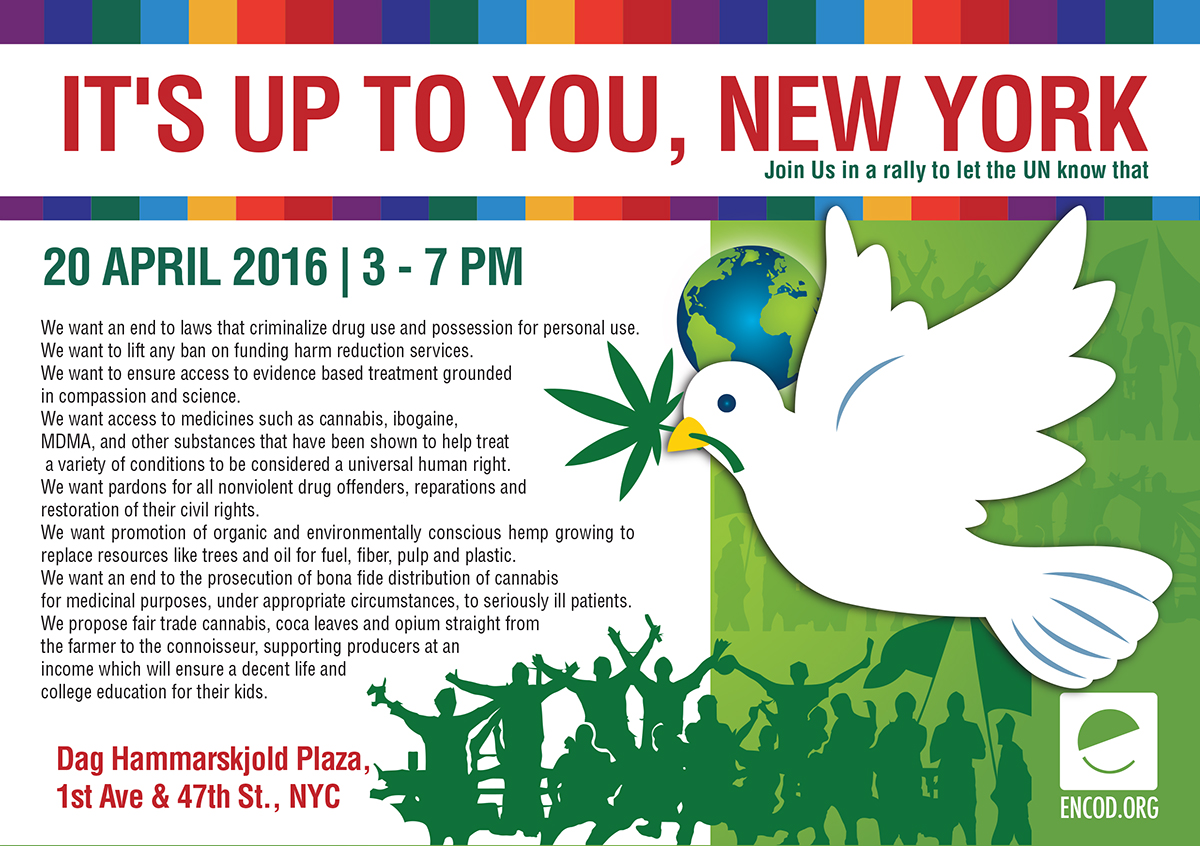ENCOD BULLETIN ON DRUG POLICIES IN EUROPE
MARCH 2016
Drug policies, prohibition and human dignity
During the course of years the most commonly used drugs change. And they change the culture, the behaviors, the environment of the consumers. There is also a change in the social perception of the consumption of drugs (or, at least, of some of them). Only one thing has not changed since 1950: the political choice of tackling the drug issue with a rigid prohibitionist approach. And yet the failure of the prohibition strategy has been universally acknowledged.
In the past few decades, the number of countries of consumption has grown, as well the quantity of the substances being consumed, also the number of drug users (occasional, habitual or chronic), the distribution areas (reaching a point where drugs are the most easily available commodity, even at night and on holidays, for the ones who know the market).
Therefore the following question becomes mandatory: does an alternative exist for this failure, one which could deal with the phenomena it induces in terms of personal suffering and social costs? To answer this question we need to give up the slogans and examine the situation (with logic and plain language).
First of all a consideration. The legislation on drugs and on their use has not always been as it is today. In Italy, the law of February 18th, 1923, number 396 (the starting point of the regulation of the sector and that, significantly, has a section “Measures for the repression of the abusive trafficking of substances with narcotic action”) did not punish individual drug consumption, but sanctioned, and in a rather light way, the acts of “group consumption” and “illicit trafficking”. This setting underwent noteworthy changes with the penal code of 1938 (albeit on the path of the authoritarian ideology of fascism), introducing the crimes of “clandestine commerce of narcotic drugs”, and “criminal facilitation of consumption and selling to minors of 16 by pharmacists”, but did not consider individual consumption, limiting to punish as a misdemeanor- in the article 729 that has now been abolished – the ones who were “caught in a public place, or in private circles, in a state of ”heavy psychic alteration due to the abuse of narcotic substances».
The use of drugs, not only by elite sectors of the population (the famous “literati and pharmacists” ) but in a more inclusive way among the social classes, was also tolerated and in fact formed part of some of the usual habits. The institutional indifference only provided repressive interventions (of a very moderate kind) when the drug consumer was disturbing the public order or the peace of third persons.
Substantially nothing in the drug law was different from the rules on alcohol, since the sale of alcohol to minors was also punishable, as well as abuse (art. 688 of the same codex) but only when productive of a state of “annoying drunkenness” (i.e. of annoyance to others). For sure, the social situation and the diffusion of narcotics were, in the first half of the past century, quite different from the current ones. However the model of institutional intervention was – even in authoritarian and paternalistic societies – exactly the opposite of punitive intervention.
The prohibitionist perspective is also, even historically, a contingent strategy that should be evaluated, just as any other strategy, on the basis of the obtained results in terms of safeguarding individual rights and of public safety. The results of this evaluation, as has been said before, are visible for everybody: prohibition has totally failed in both areas. And still we continue as if it were otherwise, and if anything, we assist sometimes to the renaissance of prohibition and punishments or to paradoxical interventions, like the introduction of a sort of inedited “penal right of the appearance”. Article 73, comma 1 bis, letter a, of the single narcotics text, as modified by the law number 49/2006, as a matter of fact foresees the punibility of the possession (and similar conducts) of “narcotic or psychotropic substances that due to the quantity, the ways of presentation or other circumstances, appear to be destined to a non exclusively personal use». Thus the penal relevance of the act is related to the appearance, not to the facts.
This approach departs, strictly speaking, from a completely ideological prejudice, centered on the ideology of good and evil, where “the evil” consists in the drug and its use. Needless to say that within this Manichean contraposition, there is no place either for evaluation of the results for the persons, nullified in their subjectivity and dignity and reduced to background actors in a crusade, with neither face nor soul. The armed wing of this ideological war is the penal repression, based in turn on the assumption, as fallacious as tranquilizing, that to forbid means to prevent and that the threat and the praxis of punishment determinate per se, in an almost automatic way, the reduction of “deviant” behaviors (in this case, the use of substances).
If we give up ideology and we look at the facts, on the other hand, the research of alternative intervention methods is not an option but a necessity. This necessity has the name and the perspective of experimentation, that is, of methods of approach that do not intend salvation but are reasonable, submitted to rigorous verifications and checks, according to the typical approach of the scientific research and of social action. That means, in concrete terms, in the sector of drugs, the pursuit of “harm reduction” policies, that is of a containment policy of the risks connected to the use of psychoactive substances through interventions of various kinds (from needle exchange to controlled consumption, to mention the most known).
A pragmatic strategy, not a defeatist one, will also turn, in the course of the coming years, into a veritable social policy that overturns the cultural option underlying prohibition (the pursuit of abstinence through punishment and social exclusion) and proposes an inclusive perspective capable of determining and favouring, on one side, responsible individual choices (including, of course, the exit from substance use) and , on the other side, the growth of the threshold of social tolerance as to the use of drugs. The immediate repercussions of drug strategy – it is important to stress it – are the persons (rather than the substances), and by prioritizing their dignity and their rights, the main attention of the government will be transferred from the penal law to health-based policies.
By Livio Pepino
Livio Pepino has been judge at the Cassation Court and member of the High Council of Judges, the self government body of the Italian judges, co-director of the magazine Narcomafie of Gruppo Abele, an Italian charity, general attorney of Torino and author of several books and articles on mafia, drug addiction and social stigmatization.
NEWS FROM THE SECRETARIAT
The coming month an Encod delegation will attend the annual meeting of the UN Commission on Narcotic Drugs and will we be preparing for UNGASS (see under).





 Creative Commons Attribution
Creative Commons Attribution